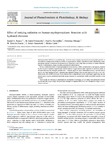Mostrar o rexistro simple do ítem
Effect of Ionizing Radiation on Human Myeloperoxidase: Reaction With Hydrated Electrons
| dc.contributor.author | Ramos, Daniel R. | |
| dc.contributor.author | Fernández-Pérez, María-Isabel | |
| dc.contributor.author | Furtmüller, Paul G. | |
| dc.contributor.author | Obinger, Christian | |
| dc.contributor.author | García-Dopico, María-Victoria | |
| dc.contributor.author | Santaballa, J. Arturo | |
| dc.contributor.author | Canle, Moisés | |
| dc.date.accessioned | 2022-03-17T12:26:54Z | |
| dc.date.available | 2022-03-17T12:26:54Z | |
| dc.date.issued | 2021-11-27 | |
| dc.identifier.citation | D.R. Ramos, M.I. Fernández, P.G. Furtmüller, C. Obinger, M.V. García, J.A. Santaballa, M. Canle, Effect of ionizing radiation on human myeloperoxidase: Reaction with hydrated electrons, Journal of Photochemistry and Photobiology B: Biology. 226 (2022) 112369. https://doi.org/10.1016/j.jphotobiol.2021.112369 | es_ES |
| dc.identifier.issn | 1011-1344 | |
| dc.identifier.uri | http://hdl.handle.net/2183/30045 | |
| dc.description | Financiado para publicación en acceso aberto: Universidade da Coruña/CISUG | es_ES |
| dc.description.abstract | [Abstract] Myeloperoxidase (MPO) is a myeloid-lineage restricted enzyme largely expressed in the azurophilic granules of neutrophils. It catalyses the formation of reactive oxygen species, mainly hypochlorous acid, contributing to anti-pathogenic defense. Disorders in the production or regulation of MPO may lead to a variety of health conditions, mainly of inflammatory origin, including autoimmune inflammation. We have studied the effect of ionizing radiation on the activity of MPO, as measured by the capacity retained by the enzyme to produce hypochlorous acid as reactive oxygen species after exposure to successive doses of solvated electrons, the strongest possible one-e− reducing agent in water. Chlorination activity was still present after a very high irradiation dose, indicating that radiation damage does not take place at the active site, hindered in the core of MPO structure. Decay kinetics show a dependence on the wavelength, supporting that the process must occur at peripheral functional groups situated on external and readily accessible locations of the enzyme. These results are relevant to understand the mechanism of resistance of our innate anti-pathogenic defense system and also to get insight into potential strategies to regulate MPO levels as a therapeutic target in autoimmune diseases. | es_ES |
| dc.description.sponsorship | This work was supported by: the Spanish Ministerio de Ciencia y Tecnología (CTQ2004-00534/BQU), the European Commission through the Access to Large-Scale Scientific Facilities Program (ref 41365), and the regional government of the Xunta de Galicia (Project GPC ED431B 2020/52) | es_ES |
| dc.description.sponsorship | Xunta de Galicia; ED431B 2020/52 | es_ES |
| dc.language.iso | eng | es_ES |
| dc.publisher | Elsevier | es_ES |
| dc.relation | info:eu-repo/grantAgreement//Plan Nacional de I+D+i 2004-2007/CTQ2004-00534%2FBQU/ES/ | |
| dc.relation.uri | https://doi.org/10.1016/j.jphotobiol.2021.112369 | es_ES |
| dc.rights | Atribución-NoComercial-SinDerivadas 4.0 Internacional | es_ES |
| dc.rights.uri | http://creativecommons.org/licenses/by-nc-nd/4.0/ | * |
| dc.subject | Myeloperoxidase | es_ES |
| dc.subject | Pulse radiolysis | es_ES |
| dc.subject | Chlorinating activity | es_ES |
| dc.subject | Oxidative stress | es_ES |
| dc.subject | Inflammation | es_ES |
| dc.title | Effect of Ionizing Radiation on Human Myeloperoxidase: Reaction With Hydrated Electrons | es_ES |
| dc.type | info:eu-repo/semantics/article | es_ES |
| dc.rights.access | info:eu-repo/semantics/openAccess | es_ES |
| UDC.journalTitle | Journal of Photochemistry and Photobiology B: Biology | es_ES |
| UDC.volume | 226 | es_ES |
| UDC.startPage | 112369 | es_ES |
| dc.identifier.doi | 10.1016/j.jphotobiol.2021.112369 |
Ficheiros no ítem
Este ítem aparece na(s) seguinte(s) colección(s)
-
GI-REACT! - Artigos [107]






